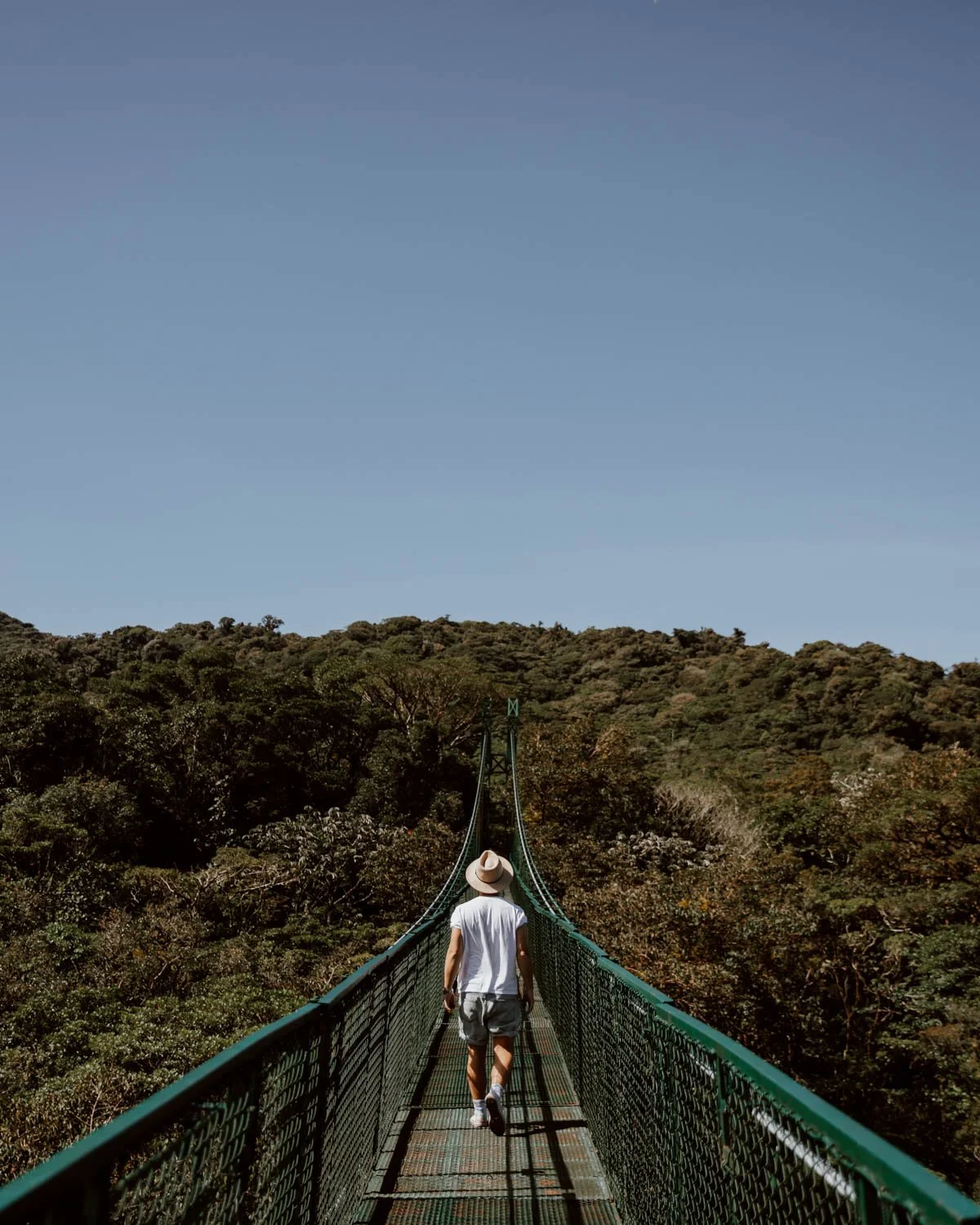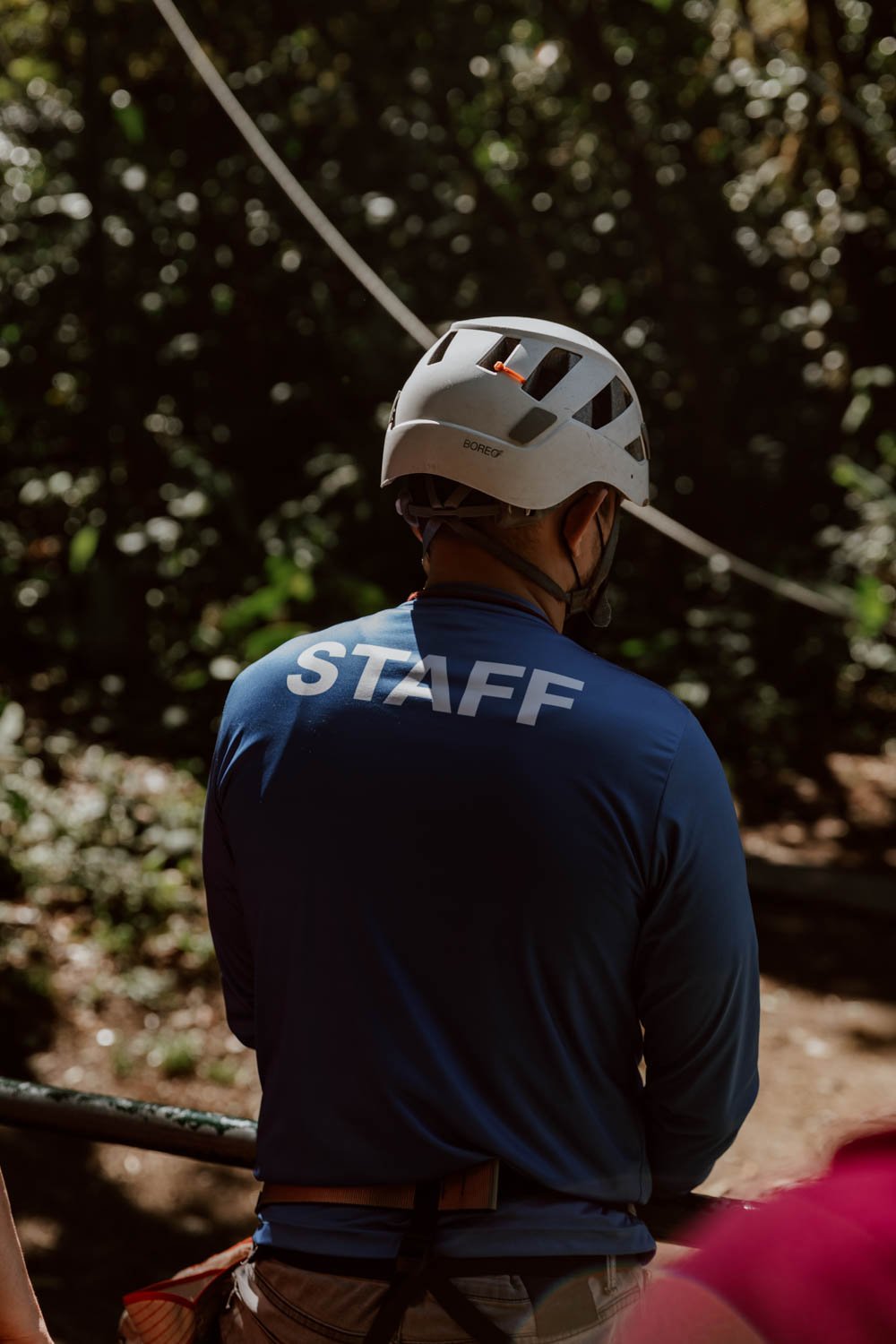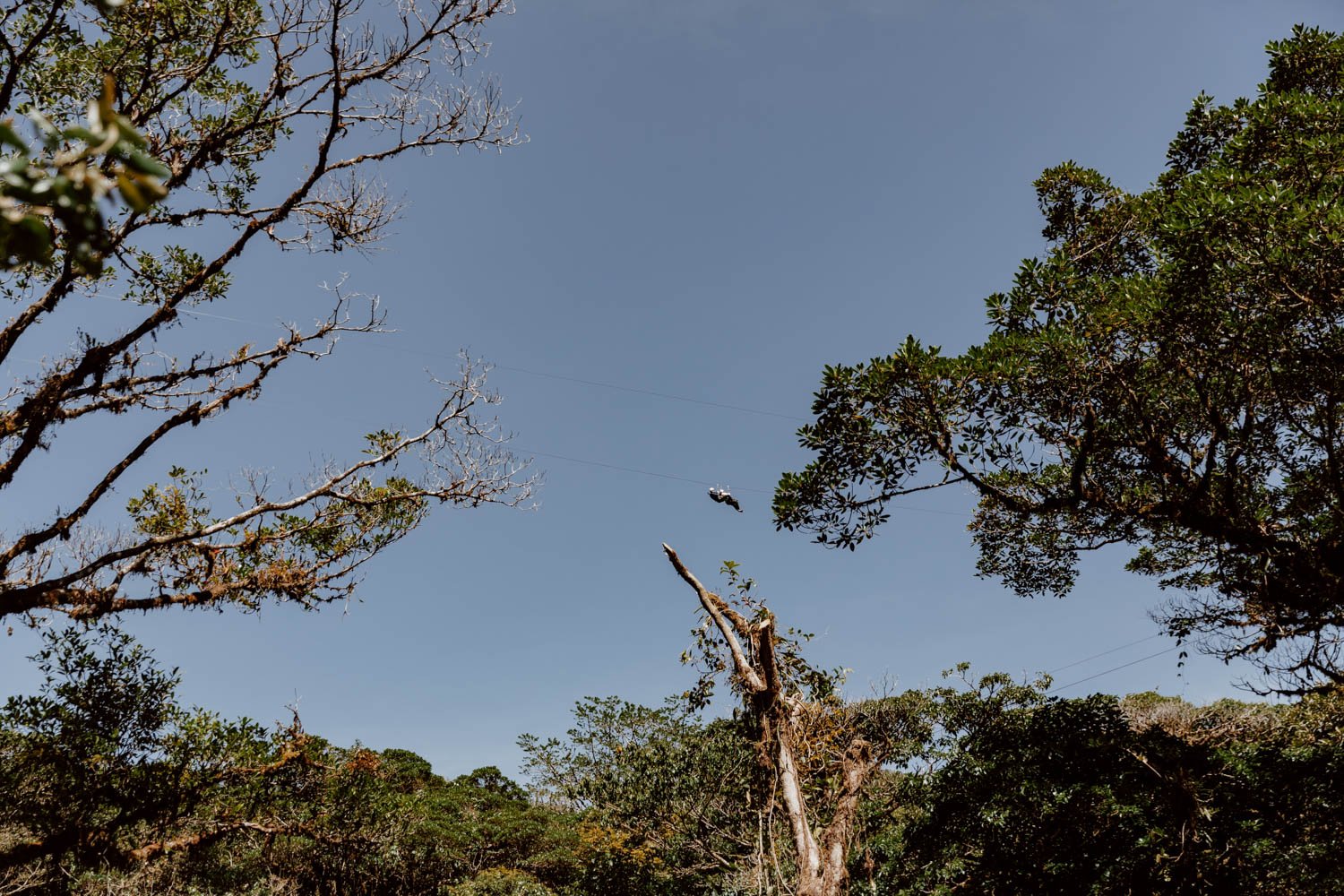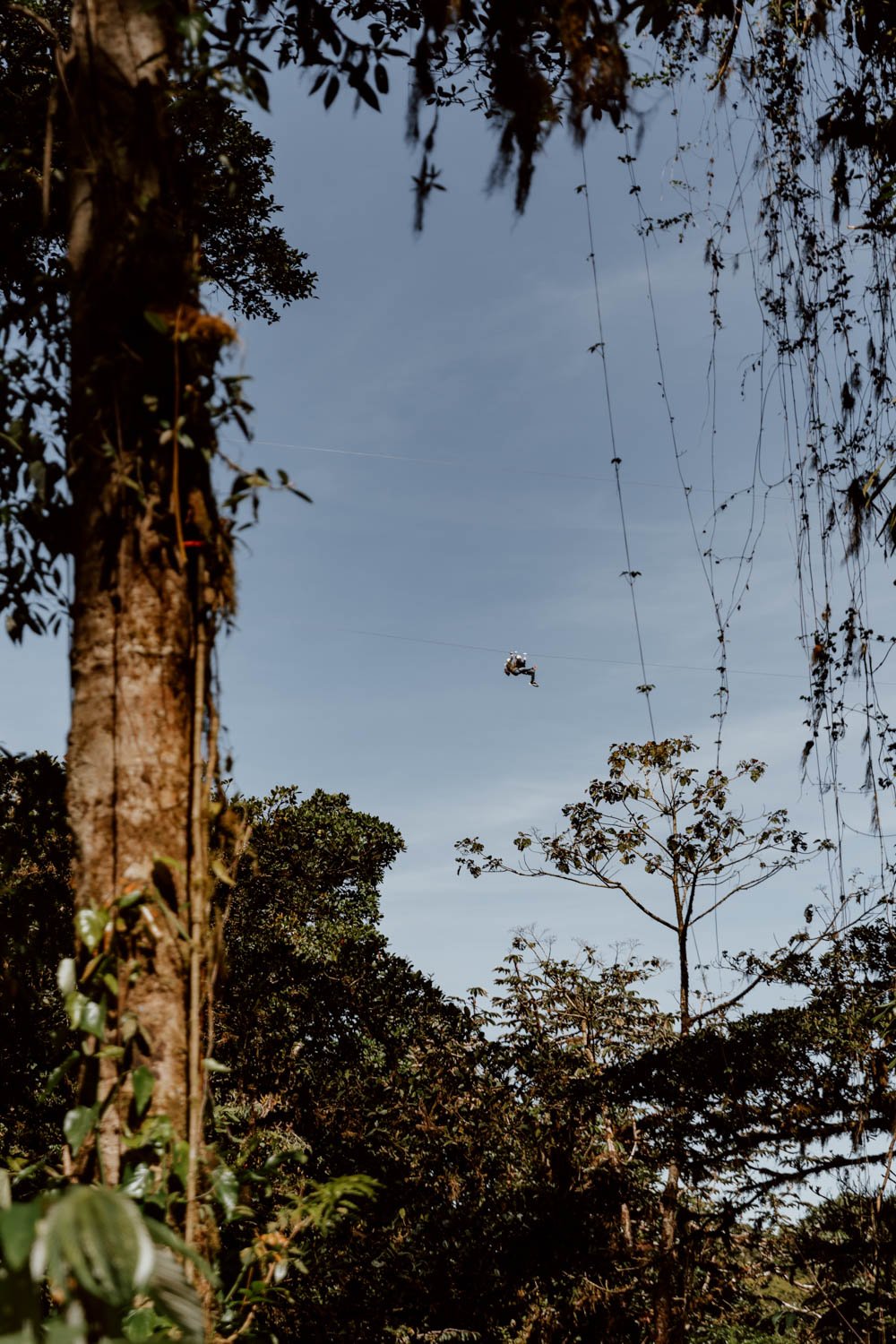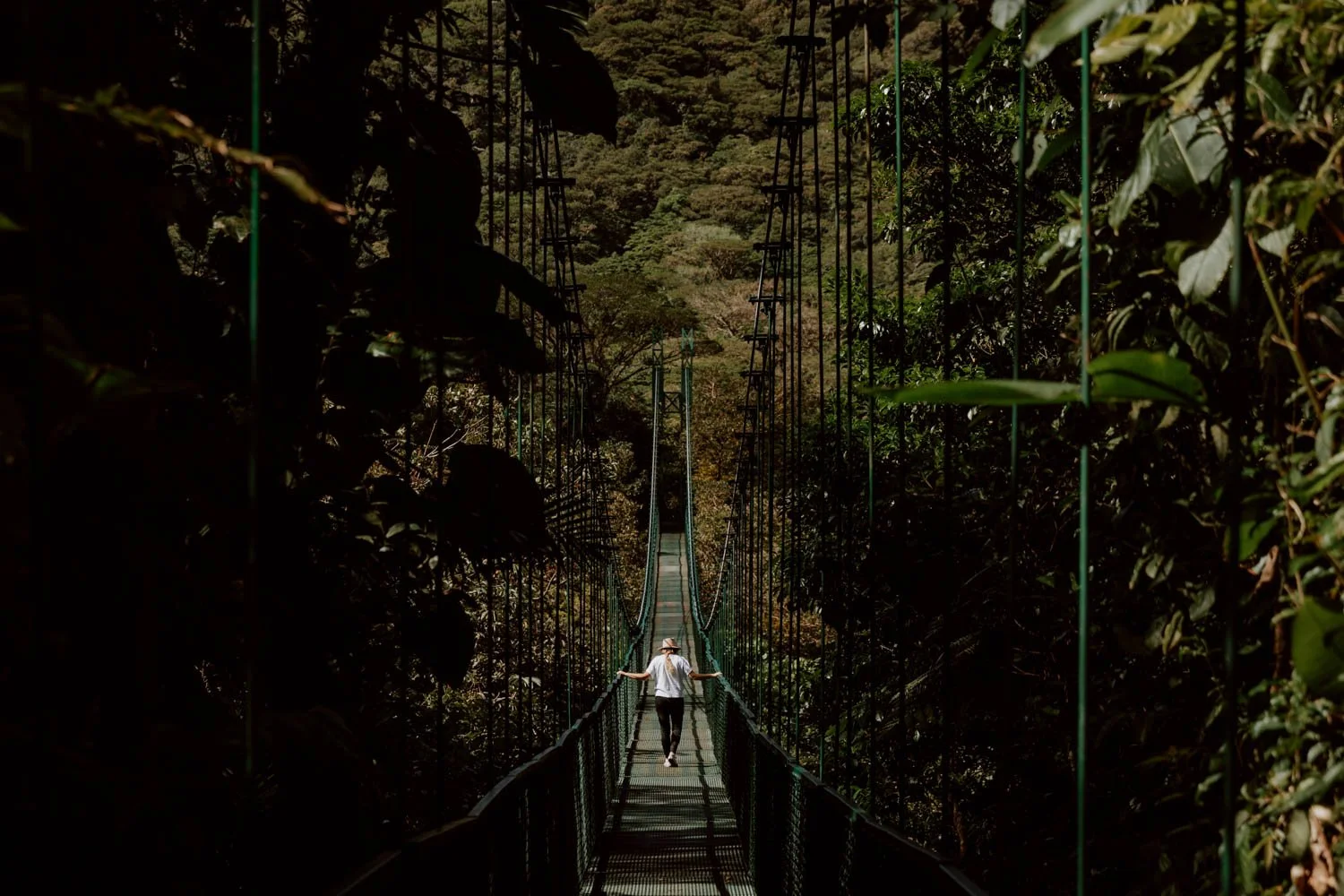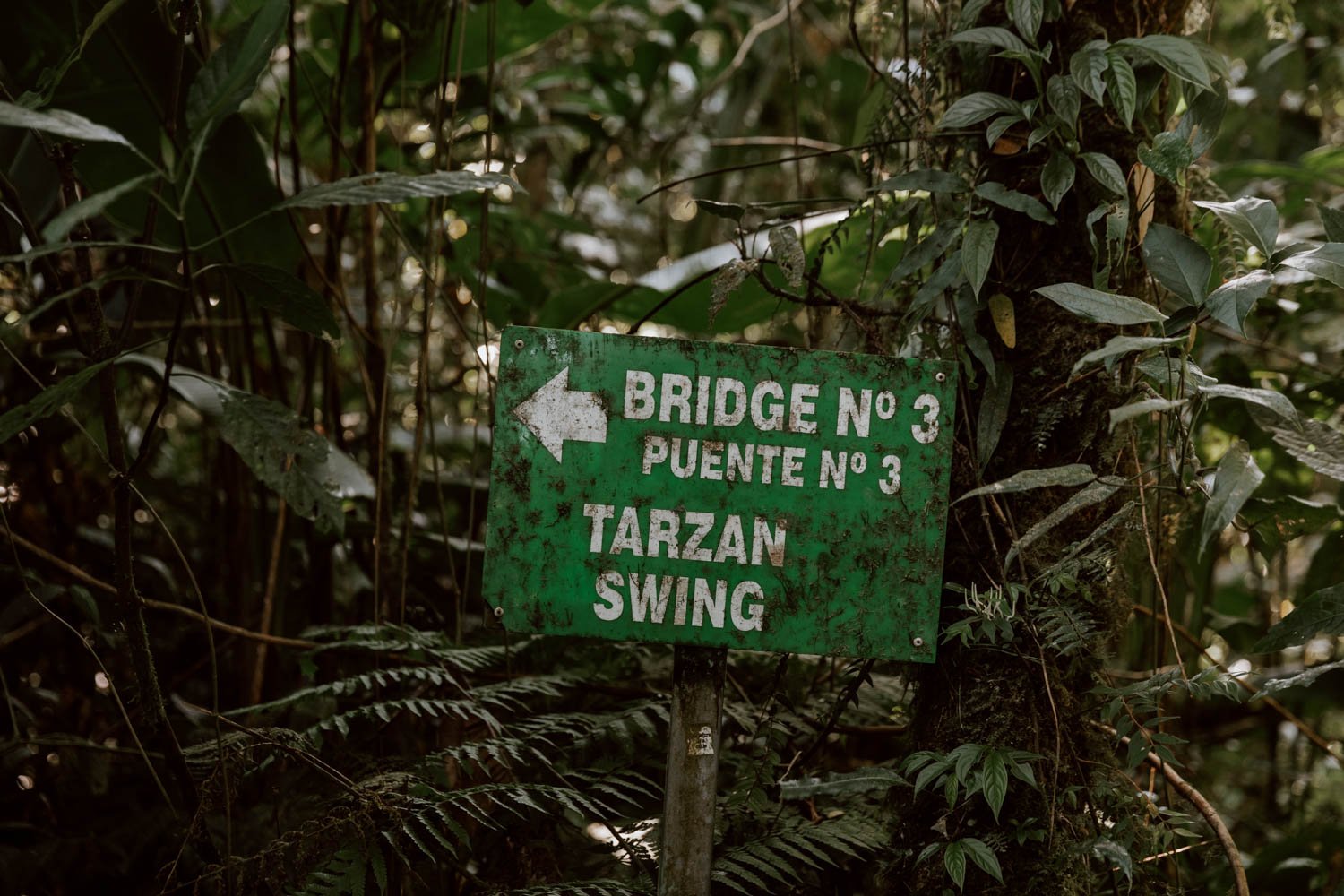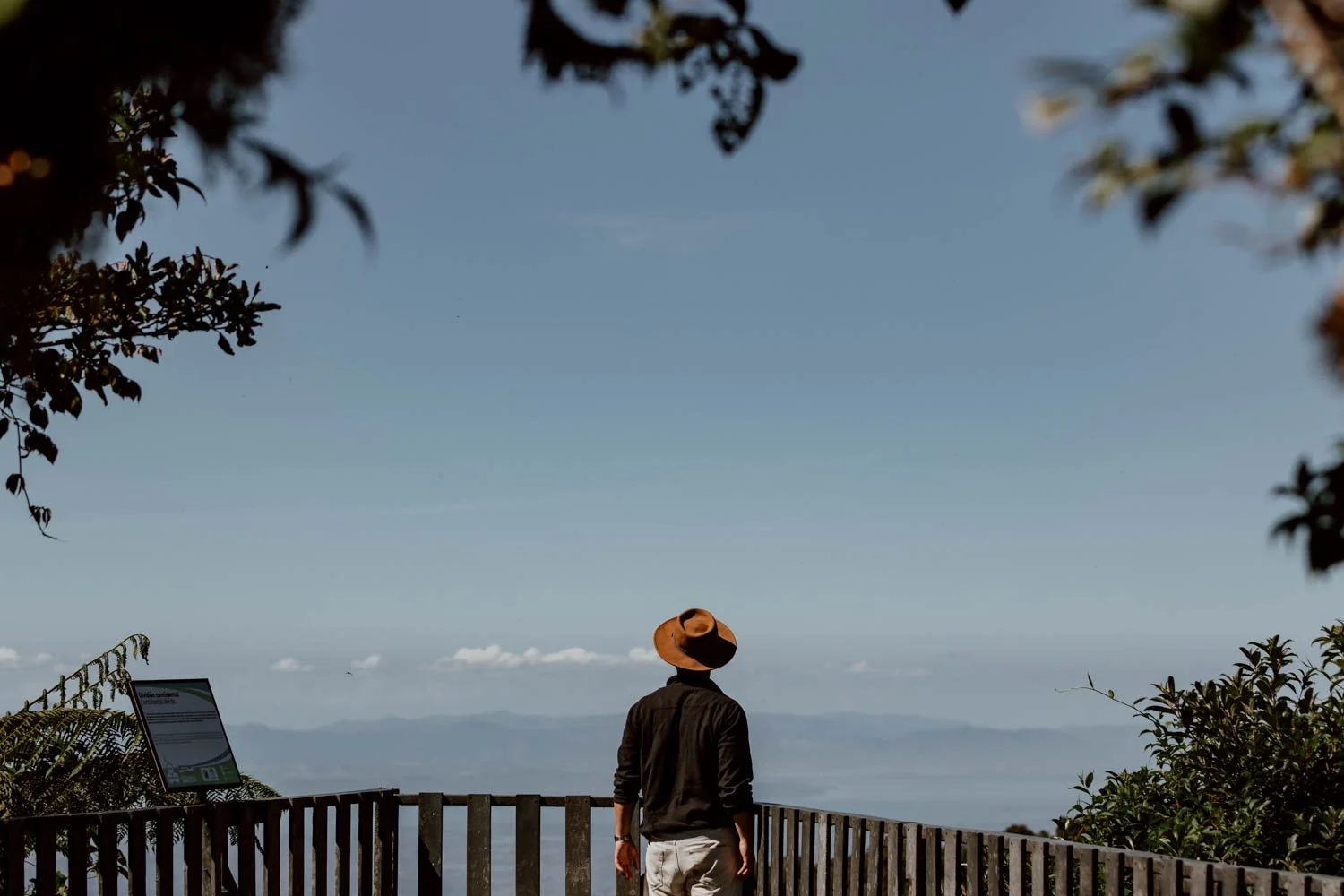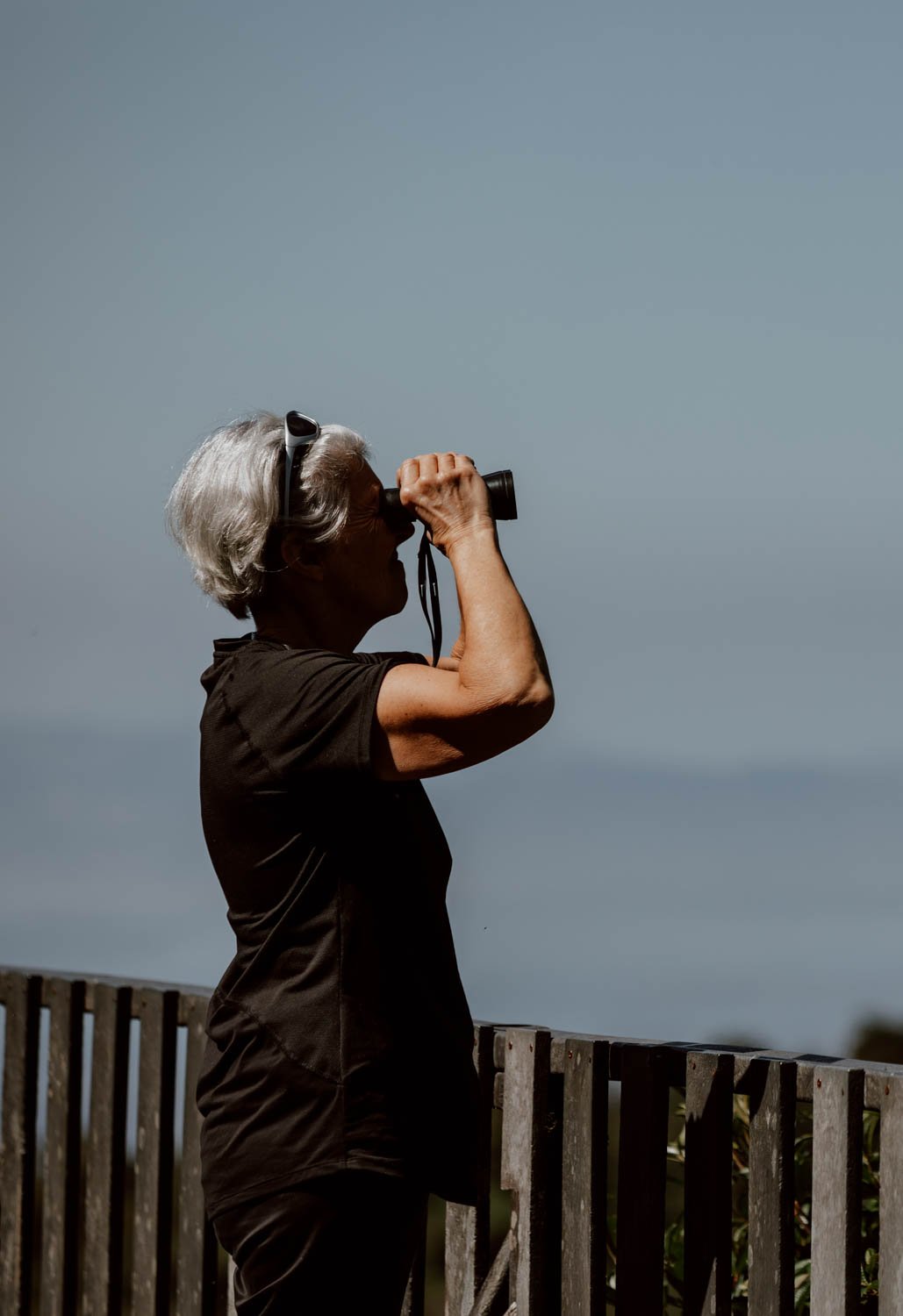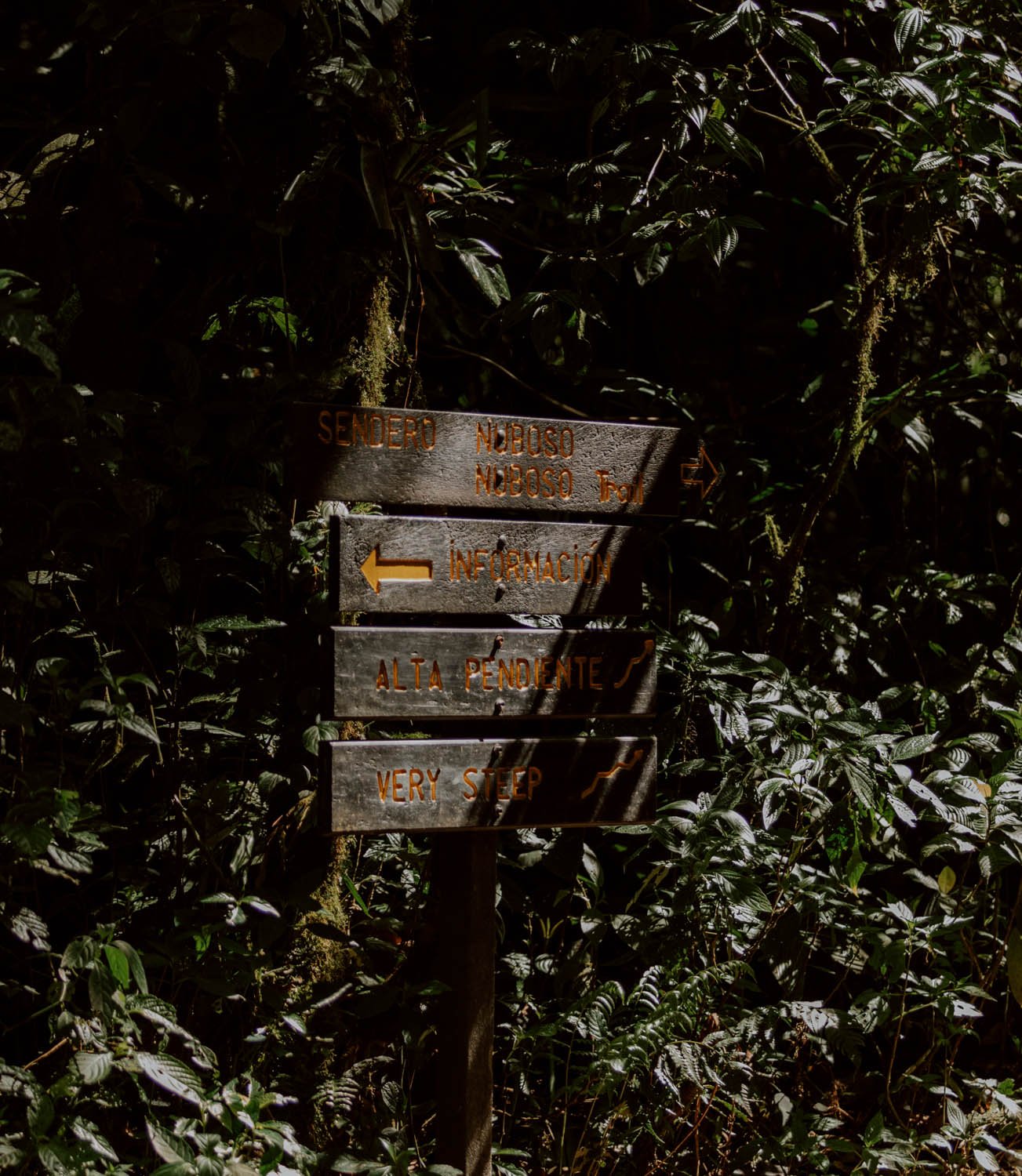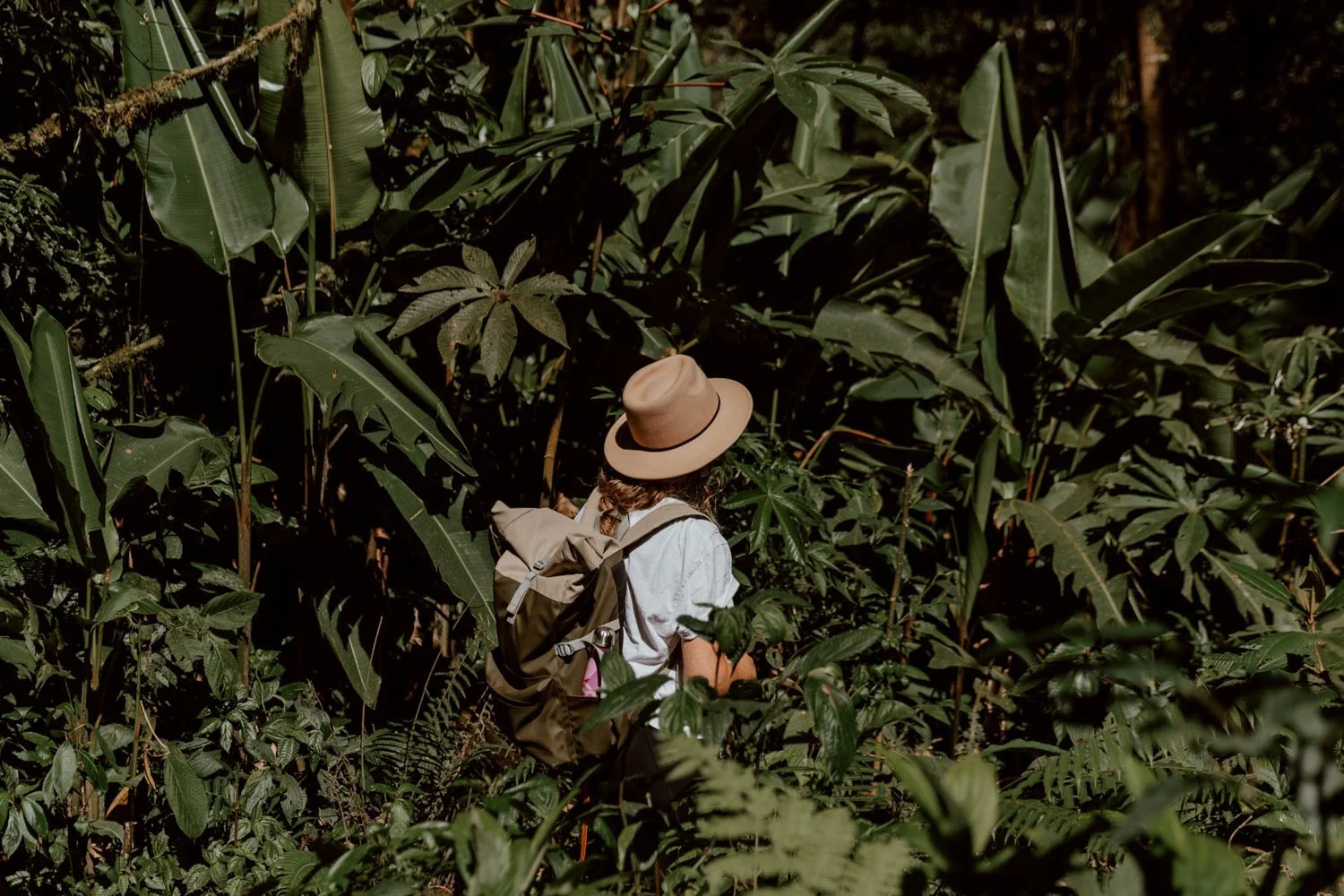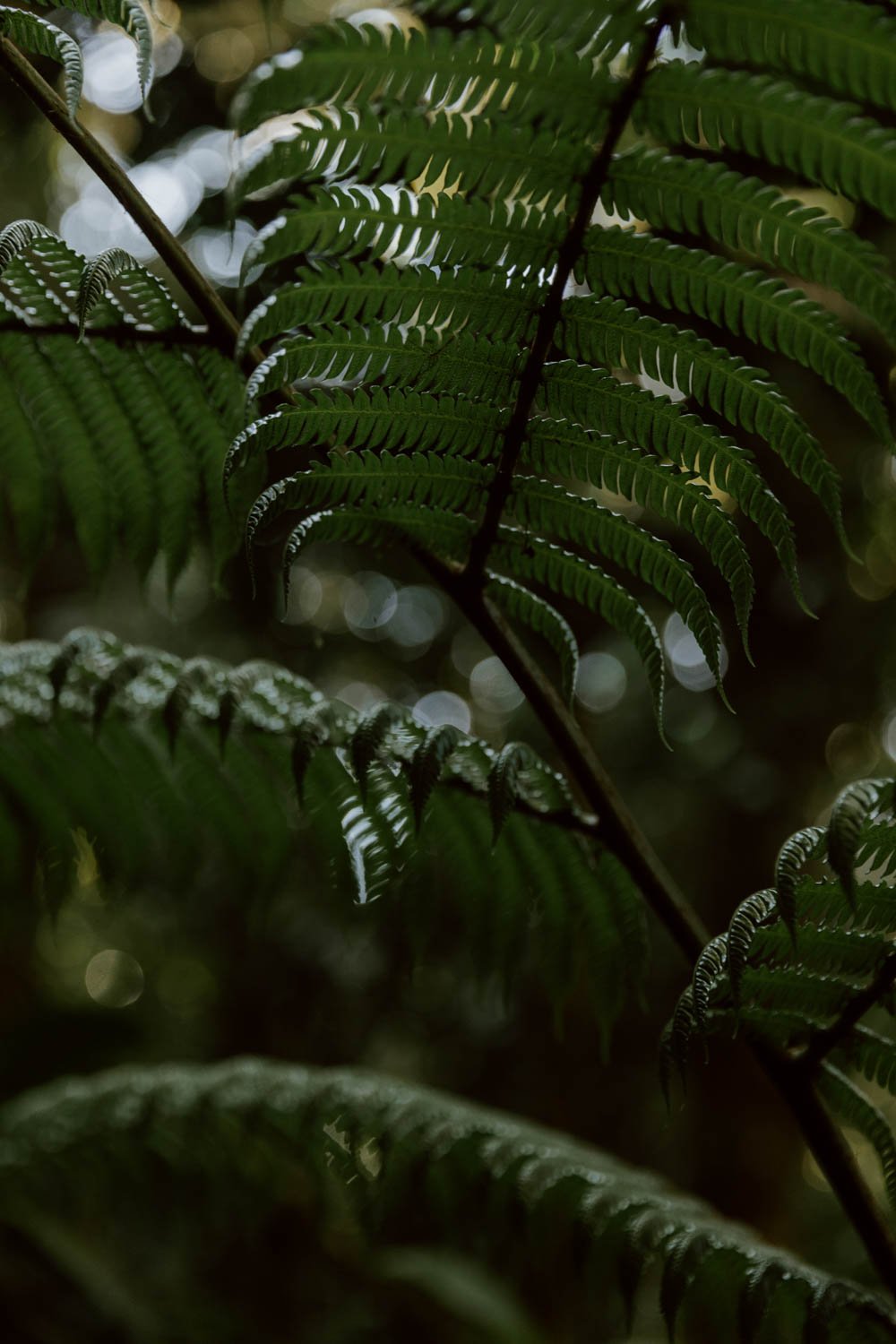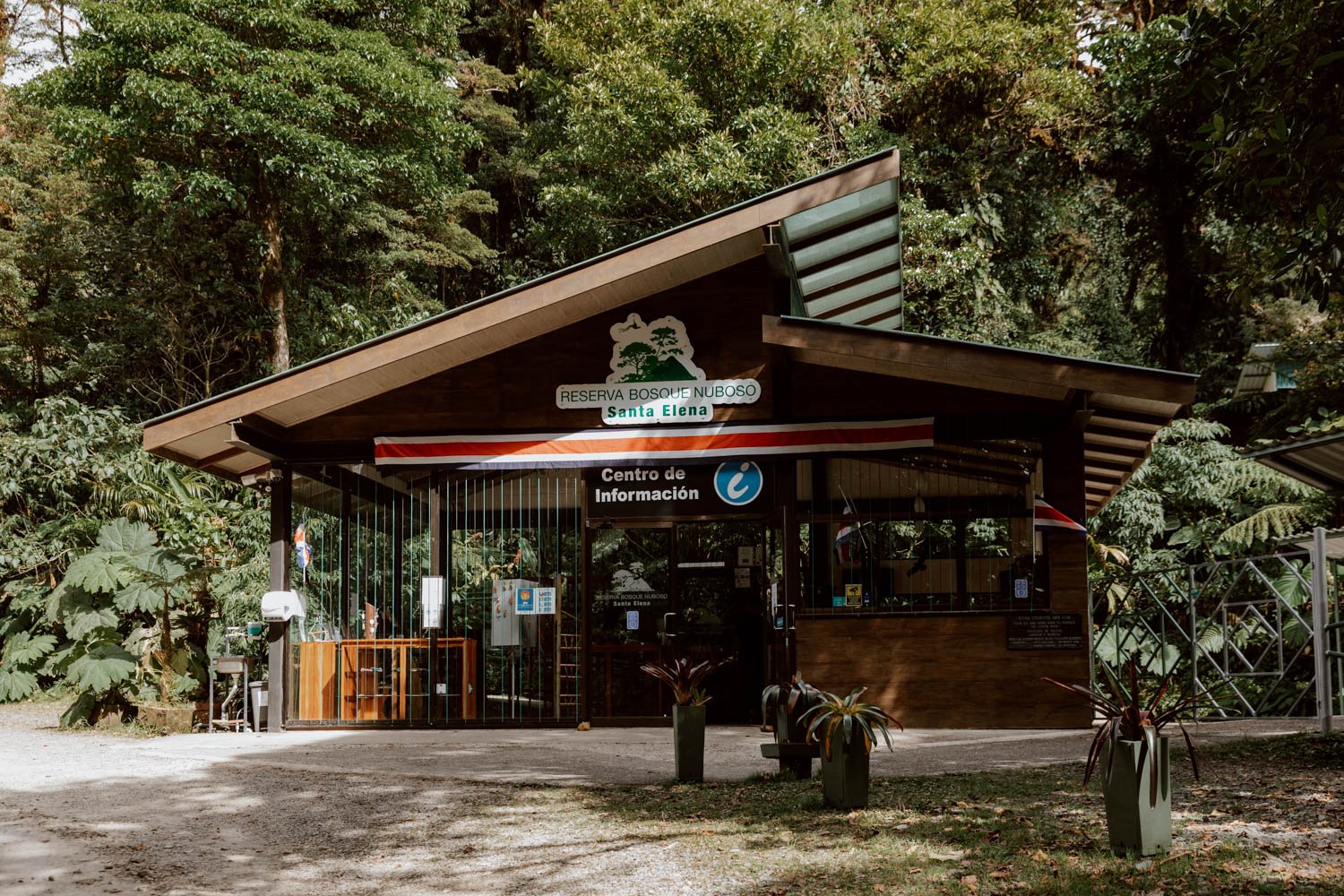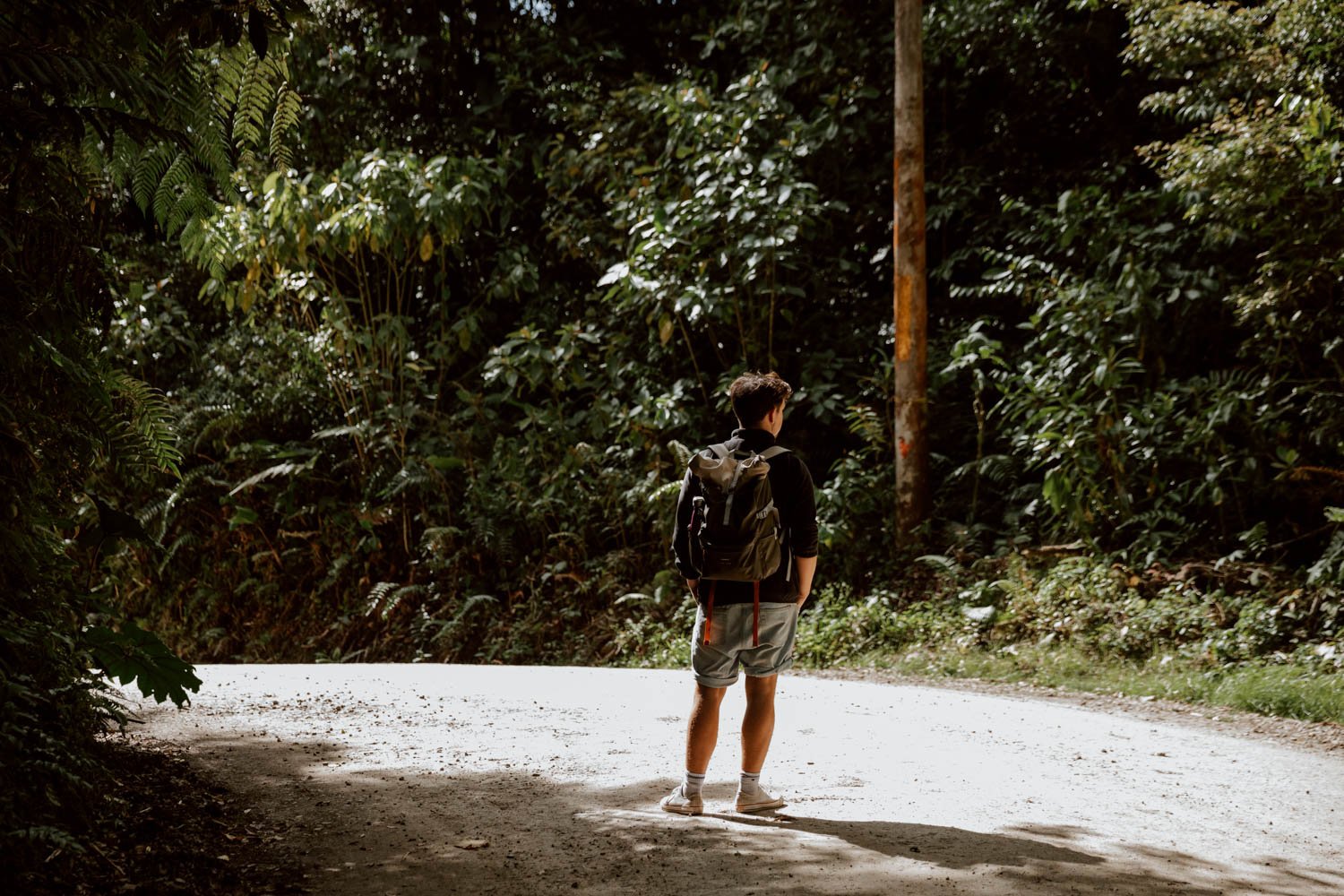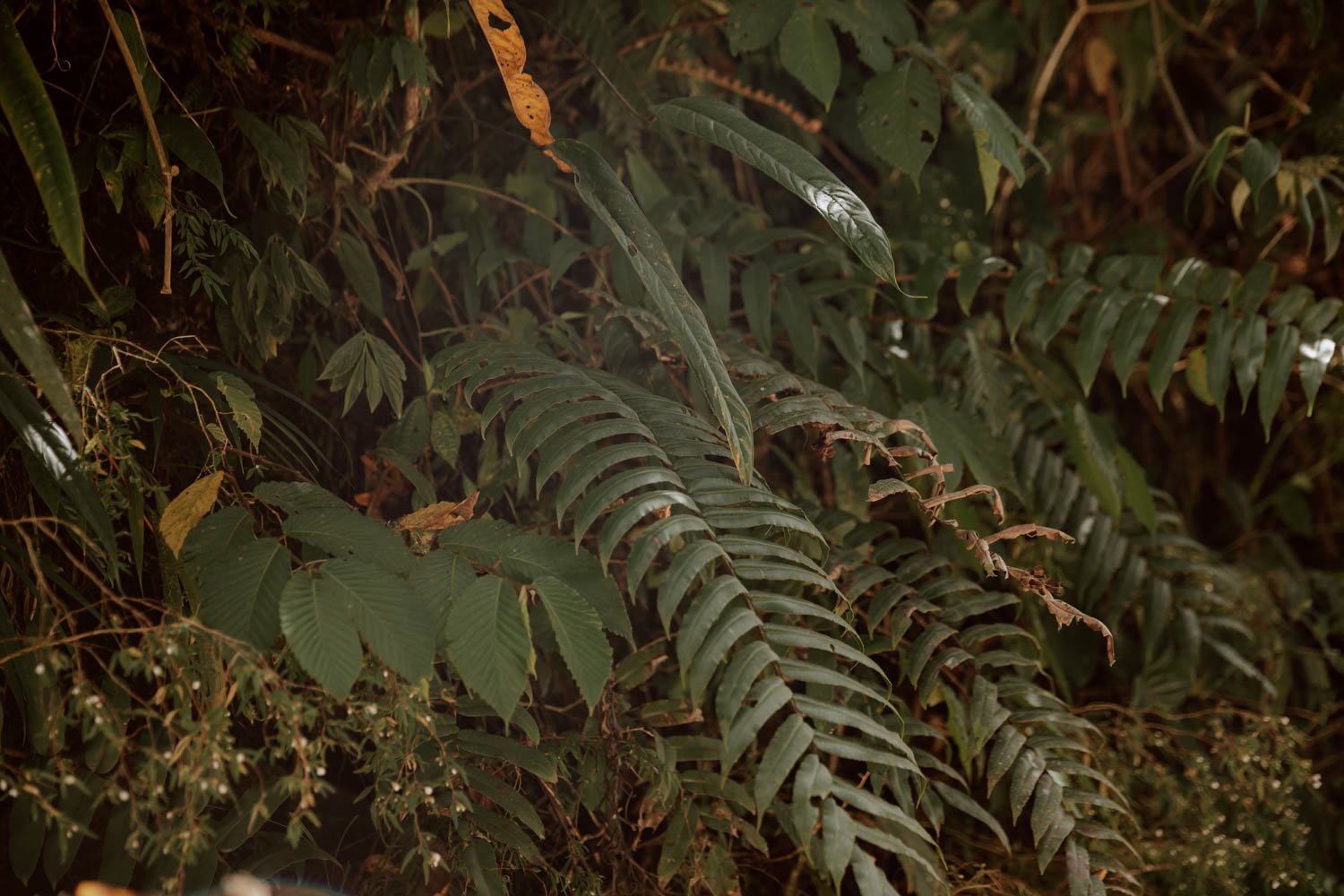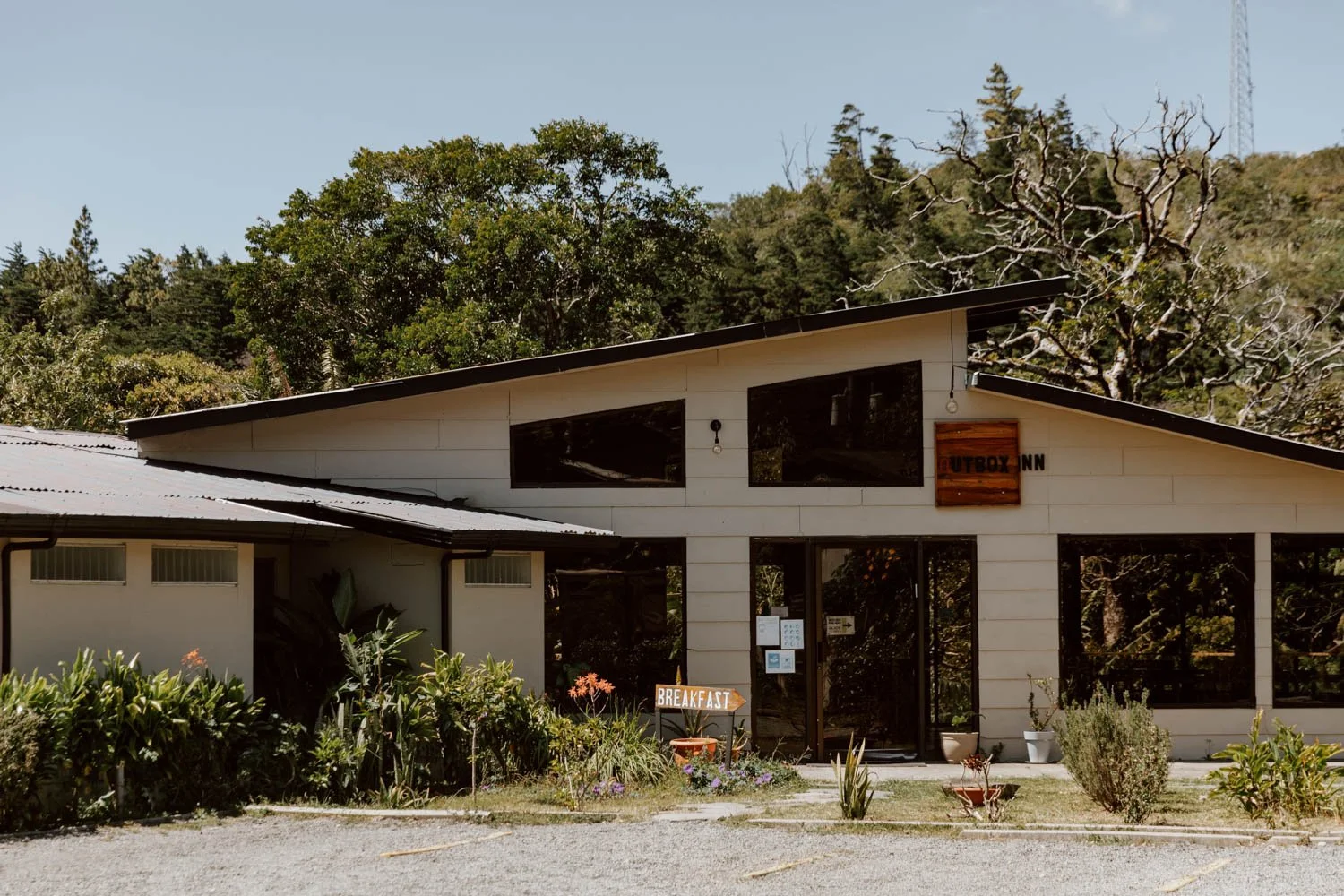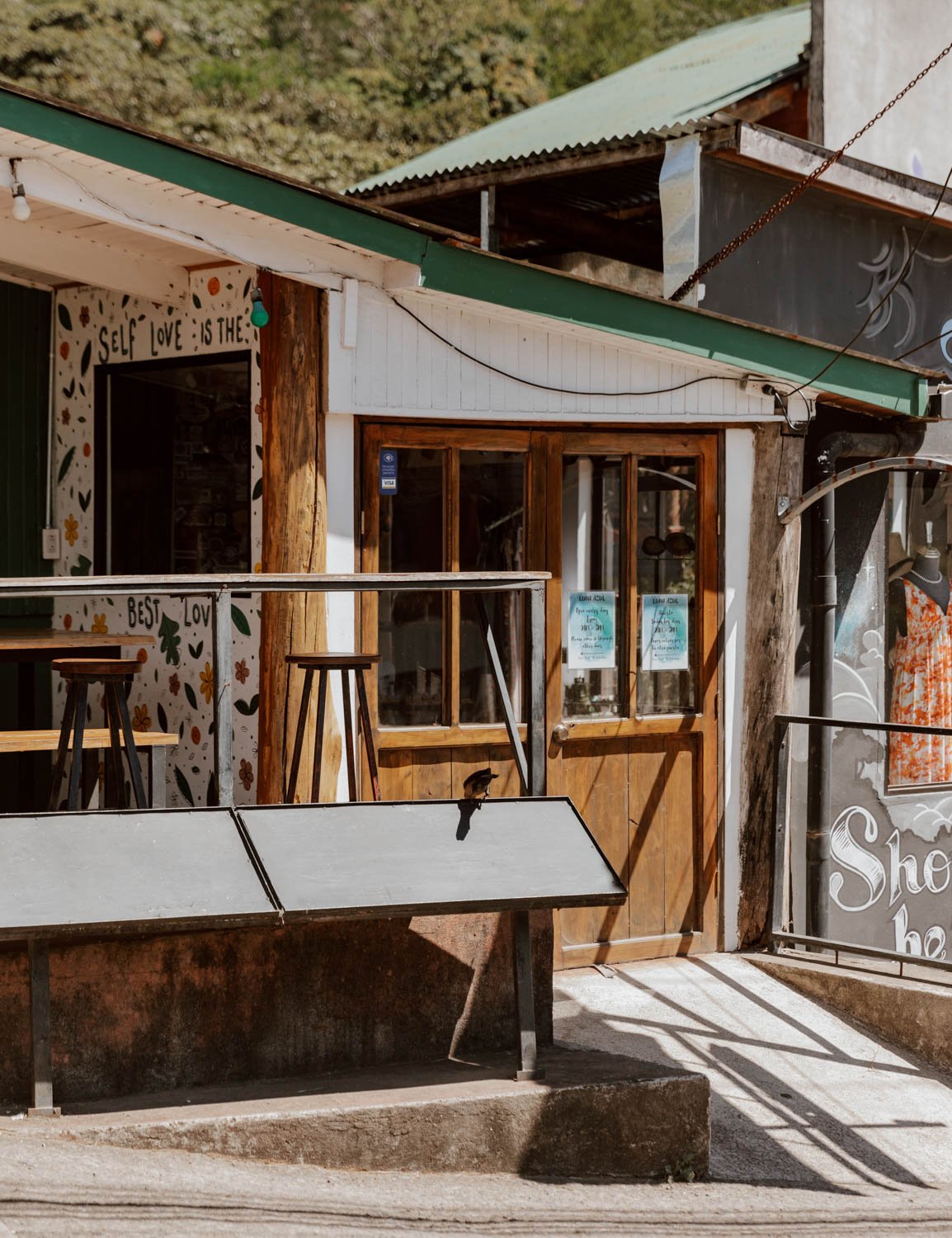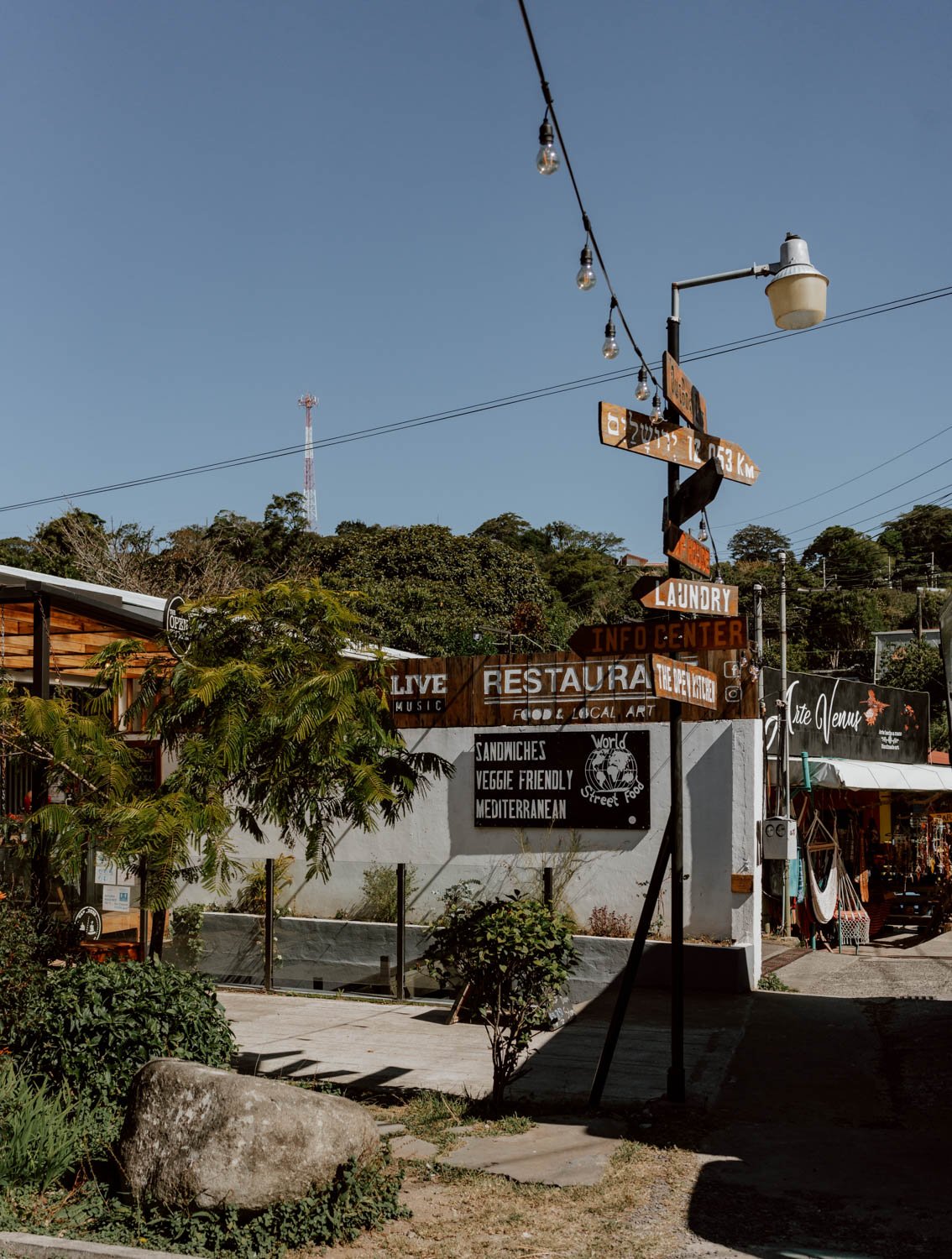Planning to visit Monteverde, Costa Rica? Our guide for travellers has got your sorted!
Updated October 2023
It took us two trips to Costa Rica before we made it to Monteverde.
On the first, we were travelling Latin America for two years on a super-tight budget, and simply couldn't afford to spend the necessary on the experiences for which this place in the clouds is famous.
Fast forward several years, and a shorter Central American adventure with more cash in our pockets meant that heading to this lush ‘mountain of green’ - a feature on nearly every single first-timer Costa Rica itinerary - was a no-brainer.
It proved memorable for reasons both good and bad.
First, the good: an exhilarating day of Andrew (almost) getting over his fear of heights and zip-lining together at quite ridiculous heights and distances above the treetops; for the families nearby, we continue to apologise for screaming bloody murder throughout and teaching your kids (and yourselves) several new British swear words.
The bad - or perhaps more accurately, the underwhelming - was the highly anticipated morning visit to the eponymous cloud forest for which Monteverde is most renowned.
For any budget or long-term traveller in Central America, it's super important to realise that if you do every outdoors activity available in Monteverde, you'll spend a small fortune. With Costa Rica already firmly established as the most expensive destination in Central America, and with Monteverde one of the most popular places for visitors doing a range of paid experiences in nature, prices are very toppy. Indeed, although there are several activities we think are unmissable here, there are others we recommend you do elsewhere (or perhaps even not at all).
So, whether you're an adventure-seeker, twitcher, coffee connoisseur, or nature-bather, we highly recommend curating your time to doing only a selection of the best things to do in Monteverde and judging your time + budget for up here in the lush, green mountains accordingly.
To help you out, in this guide for travellers we've shared the key details on the best things to do in Monteverde, plus practical tips on transport, tours, key costs, accommodation picks, and how long you really need here.
This is our guide to Monteverde, Costa Rica.
the monteverde essentials
High / Get your adrenaline fix on the zipline - we went with Selvatura Adventure Park
Hanging / Or choose a more sedate bridge walk through the forest
Nature / Explore the cloud forests (consider joining a bird watching tour to learn more)
Sample / Local coffee, cheese & chocolate
Stay / Naturave offers the most unique accommodation whereas backpackers will love OutBox Inn. Alternatively, the charming El Sol Monteverde is charming guest house
Is It Monteverde or Santa Elena?
Amongst first-time visitors, it’s a common mistake to say you're going to 'Monteverde', but where you're actually going and staying is the small mountain town called Santa Elena (Google Maps).
The reason for the misnomer is due to the nearby Monteverde cloud forest being one of the most visited and well-known places in Costa Rica, and for some reason that's superseded Santa Elena as the common name.
Santa Elena is the hub for restaurants, tour bookings, transport connections, visitor information, and amenities like ATMs and supermarkets, whilst many transport and accommodation companies will list Santa Elena rather than ‘Monteverde’. However, many of the popular activities and experiences take place in the countryside outside the town.
For consistency sake, in this post we'll use Monteverde generally for the wider region and Santa Elena when specifically referring to a business or place in the town.
The Best Things to Do in Monteverde
Go Ziplining
For travellers, ziplining and Costa Rica are synonymous, and the country is hands-down one of the best places in the world to do it. When it comes to bucket-list travel experiences, this is definitely one you can tick off!
Companies across the country have begun offering this as an activity, but Monteverde is the place which started the craze and remains the best place to give it a go. There are about a dozen zipline companies based here and it’s big business, with all of their cable runs and platforms taking advantage of the astounding cloud forest canopy, so you feel really feel like you're immersed in nature whilst shitting your pants several dozen metres above the trees.
So, if you're planning to visit Monteverde, you should absolutely be planning to do a zipline tour. We wouldn't go so far as to say that all travellers who aren't planning to zipline shouldn't even bother to venture here, but omitting it certainly decreases the 'pull' factors.
Generally, everyone can participate in the zipline experience except children under four or five (varies according to company). There are also weight restrictions in place, and you'll have to make your own judgement based on pre-existing health or fear issues.
All zipline companies in Monteverde have invested in staff, equipment, and facilities, and we spent a long time researching the reviews and credentials of each before we made a decision on where to put our money.
We eventually went for Selvatura Adventure Park, and the experience surpassed expectations. Led by team of fearless young local guides, who gave a safety briefing and demo in perfect English, our confidence grew throughout and we had a lot of fun across the series of platforms, jumps, and lines.
We even felt a little fearless ourselves until doing the last, super high, 1 km long zipline strapped together, which genuinely became quite terrifying the longer it went on - gives me goosebumps just thinking about it now; several braver people in our group even did it in the face-down superman pose!
Where + When | All of the main zipline companies have an office in town for questions + bookings, however the actual parks and lines are all a 10-15 minute drive outside of Santa Elena. A free shuttle is included in your booking and will usually collect at your accommodation but if you have a rental car in Costa Rica, you can of course make your way out there independently.
Costs | A canopy tour / ziplining experience generally lasts 2.5-3 hours, and costs range from $50-60 USD per person.
These can be booked in the offices we mentioned above or alternatively online via the official websites. You can also book with popular tour aggregators like Viator and Get Your Guide - this usually costs a little more but does mean you can make a last-minute cancellation, usually up to 24 hours before. You can find zipline tours on Viator here, and with Get Your Guide here.
Plan | We have included all the details you need to know in advance - from where to book, companies to know, what to wear, time slots, and what to do with your phone when you're up there in this post: 7 Things To Know Before Ziplining in Monteverde (published soon).
Travel Tip // Your travel insurance needs to specifically cover ziplining as an activity, and many standard policies won't include this as it's an 'adventure' activity. So, before you visit Costa Rica, make sure to double-check the small print when buying. We have the Adventure Pack policy by True Traveller, and it’s worth having a read of 13 Common Mistakes To Avoid With Travel Insurance.
Cross The Hanging Bridges
Monteverde is also the place to go and seek out that other signature Costa Rica tourism image - vast bridges and walkways suspended over the cloud forest canopy!
There are literally dozens criss-crossing the trees here, and these walkways offer unparalleled views and vantages points above the treetops, as well as the chance to feel close to nature. For those of you slightly nervous about ziplining, they also offer a much more sedate alternative to strapping yourself on a wire and wishing for the best.
What we didn't realise until we arrived in Monteverde however, was the extent to which each and every single hanging bridge is only accessible within designated, private adventure parks - the very same ones run by the companies offering ziplining in Monteverde.
On a practical level, this means you can kill two birds with one stone, and complete two of the best things to do in Monteverde in a single day. However, it does also mean, unless time and budget is unlimited, that the place you choose to zipline will also be the place you experience the hanging bridges, so you need to make sure it meets your needs for both!
It also means your costs instantly start to ramp up, but all the adventure parks do at least offer slight reductions on a variety of 'combination' packages purchased by visitors planning to zipline and walk the hanging bridges.
Plan | All the hanging bridge walks tend to follow a fixed and manageable one-way forest route, and will include around 7-10 bridges of varying heights and lengths. You can do it independently, but sometimes a tour guide is offered for an additional price.
This is a very popular activity, especially with the larger tour groups which arrive from the mid-morning onward, so crowds and bottle-necks are common. For the best experience and photos, we recommend turning up early and doing this before ziplining (which has smaller numbers and set time slots), but some parks also require you to book a specific time slot for the bridges.
Also, if you're not in a rush, simply hang back a little for larger groups to pass a bit further ahead on the trail and create a bit of distance between you (though there may be one coming up behind too...)
We recommend not viewing the bridges as a nature-spotting activity, though you may see a few birds and animals in the trees.
Costs | But here’s the rub: it's a licence to print money, with prices ranging from $40-50 USD per person for entry to just the hanging bridges. Sincerely, we think this is insane - especially given the competition between the companies - but most people will still pay it any way.
Combo tickets vary depending upon how many activities you’d like to include, but a ticket covering the hanging bridges and a canopy (zipline) tour costs around $100 USD per person (saving around $5-10 USD overall).
As with the ziplining / canopy tours, the hanging bridges expereince can be booked in the various company offices in Santa Elena, or via their official websites.
Alternatively, you can also book with popular tour aggregators - this usually costs a little more but does mean you can make a last-minute cancellation, usually up to 24 hours before. You can find highly-rated hanging bridges tours here.
Travel Tip // Santa Elena can be pleasantly warm in the day (approx 25C) but gets super chilly at night due to the altitude. In a January visit, we both needed to switch to trousers and a jumper in the afternoon once the temperatures cooled, and would be a bit more bundled up in the evenings (including in our crap hostel). So, be sure to always have a layer with you on day trips and when heading out for food at night. Typically, the best time to visit the Monteverde region is the January to April dry season, but the weather can often be quite grey, rainy and cloudy throughout the year due to the altitude and mountains. There’s also a hellish wind sometimes. September to November are the wettest months, and best avoided given the type of outdoors activities you’ll be doing.
A Walk within Monteverde Cloud Forest
Now, as travel bloggers, we think a big part of our job is to share our personal experience, as well as the inspiration + information to help you travel better. We don’t think it’s about making every place we visit and experience we have sound like the BEST THING EVER.
And so, unfortunately, our time at Monteverde Cloud Forest was one of the more underwhelming experiences we've had in Central America.
This may be because we are really fortunate to have travelled a lot of in the region, and elsewhere, and come from a part of the world where walking in the woods is a national past time. It may be because we set our expectations too high after missing out on it during first trip out here, and always feeling slightly silly for that given its primacy as a destination on the circuit. Maybe it's how we felt on that particular day and the creeping frustration with Costa Rica's insistence that (almost) every single experience and connection within nature needs to be ticketed.
Or, perhaps, it's because Monteverde Cloud Forest needs a bit of a reassessment as a travel experience.
What is a cloud forest? // A cloud forest is a rainforest at a high altitude, often cool and shrouded in mist and moisture. At certain times, it is literally within the cloud cover on the upper levels, hence the name. Due to this humid climate, it provides a distinctive, mossy habitat for a distinctive array of plants and wildlife to thrive; only 1% of remaining forests on earth are classified as 'cloud forests'.
Established in 1972 by a coalition of scientists and Quakers, Monteverde’s protects 35,809 acres has played a pivotal role in research and developing Costa Rica's reputation as a standard-bearer for positive eco-tourism and conservation. As well as protecting a vital ecosystem, it also underpins lots of scientific research - this article is really good read on the subject and the threats facing the forest.
Here at Along Dusty Roads, we donate a portion of our annual income to several environmental charities, including one solely focussed on habitat and rainforest conservation, so we 100% support the goals and impact of what's been done. Ecotourism as a driver of a local economy's income is tremendously important, and the Monteverde model is something which many other places should follow given the positive alternative it offers to a community in place of deforestation or habitat destruction.
However, that doesn't mean the visitor experience is beyond reproach.
A morning or afternoon in Monteverde is about the opportunity to explore a pristine version of this endangered type of forest via a network of walking trails. The inter-connecting 'senderos' cover 13km in total, are very manageable, and will bring you to 2% of the protected area. Beyond a curious and lush array of fauna, there’s also a waterfall, viewpoint of the continental shift, and various sections of the forest where all you need to do is stop, disconnect, and breathe in nature, or hope to spot some wildlife. There's also a hanging bridge, but this was shut for some reason, and visitors were only told this on entry.
So, why are we moaning?
Tickets | A day pass costs $25 USD for foreign adults and $12 USD for foreign children (6-12 years old) - personally we think this is far too much. Setting it at this level, beyond what many travellers will be willing to pay may diminish revenues to support conversation in the long-term. However, perhaps the point is to reduce overall visitor numbers in order to support conservation and wildlife…
It's $8 USD for Costa Rican adults or residents.
You can buy tickets online in advance on the official website or in-person at the ticket office by the main entrance. The park is open daily from 7am - 4pm, and note that there's a $12 charge if you lose the plastic card you're given to swipe.
Having previously experienced Manuel Antonio National Park with a guide, we appreciate that the chances of spotting wildlife is vastly increased with a knowledgeable expert and an accompanying telescope. Therefore, many people choose to visit Monteverde Cloud Forest on a guided tour - these can be booked in Santa Elena, but if you’d prefer to book one of line, this three hour option has hundreds of excellent reviews, with departures twice a day, 7-days a week. Find out more here.
Alternatively, this popular night walk tour offers a different perspective on the forest.
Where + When | The main entrance and ticket office for Monteverde Cloud Forest is located 5.5 kms outside Santa Elena - find it here on Google Maps.
For those of you on a Costa Rica road trip, it costs $5 USD to park and you have to leave your car at the official parking area (maps) in front of the popular Selina Hostel. This is 1km from the main entrance, but there is a regular enough free shuttle bus between the two.
For those without a rental car in Costa Rica It's necessary to take a bus from Santa Elena, which drops off and picks back up just outside the Monteverde visitor centre.
The green and white Transmonteverde bus starts journeys from this stop (maps) in the town centre and does pick up passengers along the way (but we’re not sure if this was from designated stops or people just waiting at the side of the road).
As far as we are aware, the below departure times are correct (as of October 2023) but if you visit and find the timetable has changed, please do let us know in the comments:
Santa Elena departures | 6.15am · 7.30am · 9.30am · 1.20pm · 3pm
Monteverde pick-ups | 6.40am · 8.30am · 11am · 2pm · 4pm
Travel time between the two is about 25-minutes, and we recommend turning up about 10-minutes before the scheduled departure to grab a seat. On the way back, the bus picked us up 15-minutes late, so don’t worry too much if it’s not on time (pura vida as the locals say). It’s 800 colones one-way, cash only paid to the driver.
You could also take a taxi, but I’m afraid we don’t know prices as we took the bus.
Plan | We're very pednatic on the difference between a 'hike' and a 'walk', and we'd definitely say this is a walking experinece. The walking paths are signposted and mostly in good condition, but it's best to wear hiking trainers or shoes with grip as certain sections can get quite muddy / slippy even in the dry season. If the weather has been particularly inclement, then hiking boots will be the best.
Pee before you go in and don't bring any single-use plastic.
You may be assigned and limited to a specific trail on entry if numbers are reaching capacity. Due to the public transport schedule, we could only spend three hours meandering around the trails, but four hours would have been the ideal amount of time for an unhurried walk.
The experience and conditions will differ greatly depending on the time of year you visit, and we recommend taking a look on the forest’s website for advice on this.
At the main viewpoint of the continental divide, there was an explosion of bugs, and we recommend slapping on the bug spray before you get in the park (it's not good to apply it when within a habitat zone). All visitors to Costa Rica should opt for a non-toxic, bug spray rather than the nasty feet chemical ones, and we've used te plant-based, non-animal tested Incognito Spray for years on all our travels in Latin America, and it works very well (including against mozzies).
It's possible to hire a guide or join a tour for around $20 per person, which would allow you to see more animals (we spotted a few birds, monkeys, coatis). This is a very highly-rated option available to book online, with private tours running twice a day all week.
Santa Elena Cloud Forest & The Curi-Cancha Reserve
It's also super important to know that there are alternative cloud forests and nature experiences to be had in Monteverde beyond its oldest and most famous one.
As most of you are unlikely to want to pay $61 to enter all three in a single visit to Monteverde, it's best to prioritise one or two. For something completely different, you could also just do one daytime forest trail experience and head out on this highly-rated Monteverde night walk, when more mammals are active as well as other creepy crawlies.
Santa Elena Cloud Forest
More travellers are choosing head to this smaller, community eco-tourism project.
Following the failure of using the land for agricultural research projects, the Santa Elena Cloud Forest (maps) was converted into a reserve in 1992. The goal was to use the 765 acres to conserve, educate, and support community education initiatives more generally, and it's actually leased and managed by the board of the Technical High School of Santa Elena!
Situated 1,600 metres above sea level, it has four trails in total - the Black Canyon, Low Trail, Enchanted Trail and Youth Challenge Trail - covering about 12km. You could spend 45 minutes to 4 hours exploring them all, but the Caño Negro (Black Canyon) trail is the the best to plump for if planning on a half-day visit and a bit of a proper walk.
Open daily from 7am-4pm, entry is $18 USD for foreign adults, $9 for children, and there's free parking outside small visitor centre. You can simply turn up and buy your tickets on the day, but visit the park's website for more information on hours, guided tours, nightwalks and the trails.
The Santa Elena Reserve is a 7km/15-minute drive from the town of Santa Elena, and 12km/4-minute drive from the Monteverde Cloud Forest. Whilst the bus to Monteverde Cloud Forest is public, it's a $3 private shuttle to Santa Elena so you need to reserve your spot in advance. The most convenient option is to just ask your hotel or hostel for timetables and to book it. Alternatively, we just walked the 7-minutes along a dusty road from Selvatura and Sky Adventures, meaning it is possible to visit both in a packed single day.
Curi Cancha Reserve
We're not birdwatchers, though have enjoyed doing it in the hills of Colombia, so simply couldn't make the budget or time to justify a visit to Curi Cancha.
However, given its excellent reputation amongst twitchers, we have to mention it here.
Just 3km outside Santa Elena, near the cheese factory, this small regenerated rainforest has 7km of nature trails and is home to over 200 species of birds, including the the Resplendent Quetzal, Blue-Crowned Motmot, and Orange-bellied Trogon.
You can visit independently or with a guide, which is recommended if you really want to spot feathered-critters or other indigenous wildlife. Its entry prices are however very toppy at $20 for foreign adults and $12 for the rather generous definition of children (5 to 20 years), and specialist guided tours are in addition.
You can book the tours direct, whilst there are a wider range of highly-rated birdwatching tours to book here (with free cancellation).
You can find Curi Cancha here on Google Maps. or find out more on the official website.
Travel Better // Whichever cloud forest or nature trails you walk in Monteverde, and throughout your travels, please be a responsible traveller. Don't litter, disturb wildlife, go off trail, or cause hard to the environments you’re lucky enough to be visiting. For all of us, the best rule of thumb is to ‘leave no trace, and take only memories back with you’.
Four Excellent Nature Experiences in Costa Rica
Coffee, Chocolate & Cheese
For some, those are life's essentials right there, and all of them are produced in the propitious altitude of Monteverde. You can find the hyper-local products in cafes and supermarkets in Santa Elena, or head out to the source to learn more or for a tasting experience.
The Coffee
We really liked Café Monteverde Coffee Shop in the centre of Santa Elena, and it was our pick for a morning coffee and if we wanted to hang out to make some travel plans. All the coffee they serve is from their nearby farm, and there's samples to try as well as bags of beans to buy.
They also offer daily 'seed to cup' tours, covering every part of the process, educating visitors on the role of coffee in the local economy, environment and community, and a five-cup tasting.
At $40 USD for adults / $12 USD for kids though, it is significantly more expensive than similar coffee tours we've taken elsewhere in Latin America, so long-term travellers may only wish to enjoy a cup at the cafe and save their money for later in the trip.
Tours run daily (8.30am in French & Spanish, 9.30am and 2pm in English) and last for 2.5 hours and you can book via their website or popping in to the cafe.
Alternatively, you could choose to stay in the Monteverde Coffee House, a cabin on a family’s working coffee + fruit farm outside Santa Elena.
The Chocolate
A popular alternative option is the Don Juan farm tour.
In their farm outside Santa Elena, you learn about the process for Costa Rican cacao, coffee, and sugarcane, with tastings included.
You can find out more and book the Don Juan coffee, chocolate + sugarcane tour here.
The Cheese
The Monteverde Cheese Factory sounds like an excellent name for a hipster bar, but is actually a real-life thing. It was founded in 1953 by an American Quaker community who settled out here to escape the Korean War draft (if you've been paying attention, you'll remember the Quakers also had a role in the creation of the Cloud Forest reserve), and dairy industry and factory they founded is arguably the biggest employer outwith tourism here.
Before the founders sold to an international company in 2014, it was possible to do tours + tastings, but you will still find a plethora of their 'Monteverde' brand products in the big supermarket in town.
For a more small-scale taste of the town’s dairy products, consider visiting a nearby third-generation, sustainable farm. You can try your hand at milking, take a tour of the property and meet all the animals plus enjoy a meal of freshly made cheese and locally sourced products. Find out more about the tour here.
Where To Stay in Monteverde, Costa Rica
How long do you need in Monteverde? Personally, if you plan and book your ziplines in advance, you can spend an enjoyable, activity-packed two full days. However, if relying on public transport connections, you'll likely have to spend three nights here.
The town of Santa Elena is small, and the majority of restaurants, amenities, tour company offices, and transport connections are based around the 'triangle' of streets in the centre. The centre also has the majority of hostels and guesthouses, and is the most common place to stay. However, there are a number of popular and unique hideaways in the hills and forest outside the town, which may be better picks for those with a rental car, a bigger budget, or looking to be closer to nature throughout.
We’ve done the hard work for you, and shared the best options for various travel styles: we do not recommend Cabinas Vista Al Golfo after our own time there (although the gentleman who worked on reception was incredibly helpful).
The Unique
Chaira Glamping | Fancy luxury glamping in the trees? Whilst this bubble set up isn’t 100% to our taste, it remains a hugely popular unique accommodation choice in Monteverde. Choose between the family tent (with kid friendly details like slide and climbing wall) the honeymoon tent (with hot tub) or the adventure tent. All have private outdoor kitchen. Find out more here.
Naturave #1 / Naturave #2 | Probably our favourite accommodation option in Monteverde, these two beautifully rustic split-level eco-domes set amongst the trees over incredible views over the cloud forest. Note that whilst there’s a coffee station and basic kitchenette, but it’s not really set up for cooking proper meals but it’s location just five minutes from the centre of town means this shouldn’t be a problem. Find out more here.
Borbon Tiny Cabin | This little cabin is a relatively new property but is already getting rave reviews due to its incredible views, unique design and ‘at one with nature’ vibes. An excellent breakfast is included. Around a 20 minute drive to the cloud forest so prob only for those with a car. Find out more here.
The same host actually has a number of properties (under the name ‘ Tityra Lodge’) on the same large plot of land, all beautifully designed and built with local wood, with great views to boot - see all accommodation options here.
In The Town
Camino Verde B&B | This pleasant B&B is excellently located just five minutes fro the centre of town, offers super comfortable (newly decorated) modern private rooms and a large communal balcony boasting excellent views. Breakfast is also rather good apparently! Find out more here.
Cabinas Eddy is another great alternative.
OutBox Inn | Located in the centre of Santa Elena, this is the hostel we wanted to stay in, but with a limited number of doubles the book up pretty far in advance. Sleek, contemporary design throughout, with excellent communal areas and a plant based friendly on-site restaurant. Find out more here.
Sleepers Sleep Hostel | There’s a cluster of basic, inexpensive hostels in a part of town close to the bus station - and Sleepers is the one with the best reviews. Don’t expect anything fancy, but they’re cheap, offer dorms and privates and a guest kitchen. Find out more here.
Monteverde Backpacker's | A highly-rated choice for younger budget backpackers looking for a social atmosphere and a dorm.
In The Trees
Hotel Belmar | For those looking for a traditional 4* hotel experience, Hotel Belmar is an ideal choice. The rooms are beautiful, large, and well-furnished (especially the suites), plus all come with a balcony or terrace plus views. The communal areas area also tip-top and include a hot tub and wellness/yoga studio. Find out more here.
Hotel Flor de Bromelia | This small family run hotel has exceptional reviews, with guests speaking very highly of the hospitality they receive (and the excellent breakfast). Self-contained cabins/rooms are a little basic but very comfortable and all offer views out over the trees. Find out more here.
Both with more rooms than Flor de Bromelia, if the above is fully booked take a look at Rainbow Valley Lodge or Campo Verde B&B instead.
El Sol Monteverde | Run by a family, this delightful hideaway is the antithesis to blank hotel rooms, with bright colour throughout and a host that will go out of their way to make your stay perfect. Accommodation is within individual cabins, all nestled away in gorgeous gardens surrounded by breathtaking views. There’s even a stunning little stone pool! Find out more here.
Alas Chalet | This beautiful chalet-style house is split across two levels, with a living area and small kitchen downstairs and a large bedroom with truly spectacular views above. Designs is modern and stylish. and the property super comfortable and ideal for a couple. Find out more here.
Two other accommodations to take a look at include: La Guayaba Monteverde and Los Pinos Cabins & Reserve.
Selina | Located within walking distance to the cloud forest, Selina is the flashpackers and digital nomad hostel of choice. The uber-bouiji interiors are super modern and well designed, and communal areas numerous (including co-working space, hot tubs, yoga deck plus restaurant and bar). Do note that its location means you’ll mostly eat here rather than in town. Find out more here.
The Green Tree B&B | If you’re looking for a good value treehouse hideaway, be sure to take a look at this place. It’s a little rustic but previous guests speak very highly of the nature-based experience on offer. Find out more here.
Where To Eat in Monteverde
All of our recommendations are in central Santa Elena, but there are a few places outside the town for those of you with a car. All of the zipline adventure centres, as well as the Monteverde Cloud Forest, have restaurants on site as well (but those on a budget may prefer to bring snacks or a lunch).
We've included places we ate at below, as well as a few other recommendations we liked the look of, but don't forget that a positive way to spread your spend is to also eat at smaller, local-owned sodas here and elsewhere in Costa Rica.
Café Monteverde Coffee Shop (maps) for good coffee and wifi. We didn't visit the nearby Zuccaro Coffee & Bakery (maps), but its pastires did look excellent.
CASEM’s non-profit cooperative shop and restaurant, which supports employment opportunities for local women as well as arts, crafts, and business management training. Find it here.
Taco Taco Taqueria: A cool spot and the most gringo-ish hangout in the evenings. Owned by an American ex-pat, the food is pretty good, but portions small for the prices. Excellent micheladas. It gets really busy in the evenings, so not a bad idea to reserve a table if there's a bunch of you or your heart is set on Tex-Mex. Find it here on Google Maps.
The Open Kitchen: Attached to the best hostel in town, this serves fresh, healthy things travellers want in a cool, bright space. Very veggie-friendly. However, we have to say that we didn't eat here because the prices seemed a bit out of whack, and we really fancied a burger and a beer that day.
Gusticos Monteverde: Which is how we ended up here. Decent veggie burger, although as is common throughout Central America, it's made of lentils and beans rather than something a bit more girthy (can't complain though). Otherwise, there are several other excellent veggie options and meat burgers, as well as standard tico fare. Find it here.
Restaurante Tico y Rico (maps): a good option nearby for all sorts of local and international dishes at decent prices.
Choco Café Restaurant and Coffee Shop : popular with tourists, but we didn't eat there as it's the other side of town from the 'triangle'. Find it here.
Whilst Emily has vague recollections of drunken nights during her visit to Monteverde way back in 2006, in our experience this isn't a place that's really focussed on nightlife - which isn't surprising given what most visitors come here to do. There are some places to drink in town - The Beer Garden Monteverde (maps) is definitely worth a stop - but the hostel is as good a bet as any.
Things to know / Amenities in Monteverde
| The Monteverde Tourist office on the corner of the triangle (maps) is super helpful for all advice, especially on the rather opaque onward transport connections and schedules - they speak excellent English but happy to converse in Spanish too.
| Monteverde's small bus station is a wee bit of an up/down walk from the 'triangle', and not so fun it it's dark, raining, and your hostel is on the other side of town and up another hill. If arriving by bus, you will want to make sure that your accommodation isn’t too far away on foot. It's got a delightfully dated small ticket office, and cash is best - find it here on Google Maps.
| You can find the red taxis lined up outside Mercardo Vargas (maps) if you need a ride to an activity, or don't want to take the bus for your next destination.
| SuperCompro (maps) is the largest supermarket in town, well-priced, and has everything you'll need.
| There's also a reliable ATM next to SuperCompro, which didn't charge withdrawal fees for our Starling cards. There are several other ATMS in Monteverde too.



